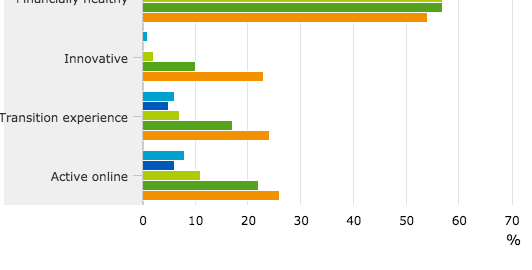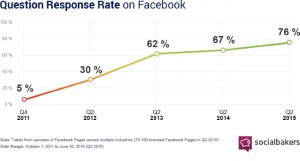— June 14, 2019
![How Automation Helps [Small] Businesses Increase Agility How Automation Helps [Small] Businesses Increase Agility](https://www.onlinesalesguidetip.com/wp-content/uploads/2019/06/01-How-Automation-Helps-Small-Businesses-Increase-Agility.jpg)
Rapid change and technology have made organizational agility an absolute must for businesses in the 21st century. If efficiency was the key to success in the industrial age, agility is the new determining factor for success in the age of technology.
“Success today requires the agility and drive to constantly rethink, reinvigorate, react, and reinvent.”
– Bill Gates
A business can be agile by setting systems in place that allow its decision-makers to react rapidly to changes with minimal disruption. It must be fully prepared to adapt and remain flexible for long-term success.
A survey by McKinsey found a correlation between high volatility and unpredictability in an industry and the degree of agility companies adopt to combat this instability.
![How Automation Helps [Small] Businesses Increase Agility How Automation Helps [Small] Businesses Increase Agility](https://www.onlinesalesguidetip.com/wp-content/uploads/2019/06/02-How-Automation-Helps-Small-Businesses-Increase-Agility.png)
According to McKinsey, the need for agility arises from four trends disrupting the current paradigm:
- Quickly evolving environment
- Constant introduction of disruptive technology
- Accelerating digitization and democratization of information
- The new war for talent
The idea is that agility is the key to stability. Because of these new factors that change from day to day, businesses that can’t evolve and change quickly will fall behind. Agility isn’t just about efficiency anymore, it’s about staying competitive.
New technologies like machine learning (ML) and artificial intelligence (AI) disrupt processes by democratizing information and necessitate highly-skilled talent well-versed in the technologies. The systems are data-intensive and rely on rapidly processing high volumes of digital data that can’t be done by humans alone.
In a world awash in data, becoming a data-first organization is crucial for small and large businesses alike. Data-based automation will, therefore, form a necessary part of agility.
Here are three ways your business can increase agility through automation.
Scalability
Within healthcare, remaining agile isn’t just about business. It’s about saving lives. In the case of the UK National Health Service Blood and Transplant (NHSBT), moving from their internal IT system to a cloud-based automation platform radically transformed their incredibly complex organ allocation process. By having the platform automate 40% of its 96-step allocation process, NHSBT sped up the organ transplant backlog so that patients could receive faster care, saving lives.
Complex internal systems can be very difficult and costly to navigate, especially as IT engineers must manually maintain and upgrade the software. Those who might need access to the system have to constantly rely on IT support, slowing down the process. Switching to cloud-based automation software gets rid of this problem by saving IT costs as well as providing a user-friendly platform that’s easy for all parties to use and update.
Following the economic downturn in 2008, almost 90% of businesses surveyed by The Economist Intelligence Unit stated agility as one of the most critical factors for success. Within that context, 38% stated that improving process efficiency was their priority for improving agility, while another 33% said improving knowledge management and sharing of information was their priority.
With research from MIT showing that agile organizations see 30% higher profits than non-agile ones, automating processes and workflows to achieve agility remains the key to business success at scale.
Security
One of the side effects of data digitization is the increased security risk. Breaches and hacks are becoming all too common and businesses must take steps to guard sensitive information. In the 2017 State of Network report, protecting data against breaches and leaks was the top priority for Small to Midsize Enterprises (SMEs) and large enterprises alike.
It may seem like the philosophy of business agility––rapid decision-making, quick changes to processes, etc––might be in conflict with security since you need time to implement security measures while making those quick changes. Using a platform built to stay open to frequent updates also invites cyber attackers with many vulnerable points. But automating at least parts of cybersecurity is now more important than ever, due to growing cyber threats.
Security automation seeks to relieve some of the pressure off of IT engineers working in an increasingly overwhelming cybersecurity environment. For example, in Illinois’ West Aurora School District 129, there are just two network engineers securing data for 12,700 students, 1,900 staff and over 10,000 connected devices. So when a DDoS attack took down the network for six weeks, they struggled to identify the source of the problem. There simply aren’t enough engineers to combat the constant attacks and threats, especially for smaller businesses that are stretched for resources.
A recent report by Skybox shows that the security industry is increasingly adopting automation for some of their core processes, including collecting/gathering data for attack surface visibility and modeling, network change management, and rule life cycle management: “There are many areas … where it is absolutely essential to implement automation … Networks are simply becoming too large and complex to manage manually. If you’re not already working with a vendor in these areas, you should start looking for one.”
The large volume of data vulnerable to security breaches, along with the ever-increasing pace of cyberattacks, make it inevitable for businesses to adopt security automation to remain agile in the face of this changing environment.
Data Analytics
One of the biggest benefits of process automation for businesses is data analytics. Simply put, advanced data analytics can help key decision makers uncover bottlenecks, improve efficiency, and identify areas for optimization. Digitized operations generate this kind of data for analysis.
By 2020, the total volume of data is expected to reach 44 trillion GB, or 1.7 megabytes of new information generated per second per human. Business investments are moving in the direction of big data services, primarily provided by companies like IBM, Dell, and Oracle. A new survey by NewVantage Partners revealed that 55% of companies invested over $ 50 million in big data and AI, up from 40% last year.
Though large enterprises are leading the charge, research shows that SMEs are also ready for big data.
![How Automation Helps [Small] Businesses Increase Agility How Automation Helps [Small] Businesses Increase Agility](https://www.onlinesalesguidetip.com/wp-content/uploads/2019/06/03-How-Automation-Helps-Small-Businesses-Increase-Agility.png)
After analyzing the data from their operations, the Point Defiance Zoo & Aquarium in Tacoma, Washington was able to predict how many guests would visit the location depending on the weather. This helped them deploy the right number of employees onto the site. Likewise, the data also analyzed customer behavior for online ticket purchases, leading to a whopping 771% increase in online sales in two years.
The zoo’s business and administration service manager, Donna Powell, summarized the benefit: “For a minimal investment of less than $ 4,000, we sold $ 60,000 worth of memberships.”
A Kofax case study report shows other instances of businesses implementing process automation to achieve results, including:
- A European bank that saved thousands of hours a week on Know Your Customer checks
- A business that automated special quotes and invoices, saving hundreds of hours per month
- An insurer that adjudicated claims 75% faster with RPA
Businesses both big and small can adopt process automation and data analysis to increase operational efficiency and generate higher revenue. But focusing on shaping a data-driven culture will produce even better results than chasing short-term ROI.
Automation and Agility Are Two Sides of the Same Coin
Lean, agile processes focused on flexibility and productivity are on the rise for both big and small businesses. Agile organizations tend to be healthier, more profitable, and innovative. But in order to achieve an agile business culture, automation plays a pivotal role.
Without the benefit of automation and data analytics, businesses will struggle to remain agile. The speed of technological growth and the exploding volume of data simply make it impossible to work efficiently without automated processes. SMEs and enterprises need to make investments in automation and digital data as a core differentiator for business success.
Business & Finance Articles on Business 2 Community
(57)







